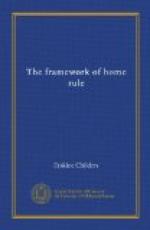The American Revolution and the Irish revolutionary renaissance—the one achieved by a long and bitter war, the other without bloodshed—originated and culminated together, were derived from the same sources, and ran their course in close connection. In Ireland the movement was exclusively Protestant, in America unsectarian; but in both cases finance was the lever of emancipation. America, resenting the commercial restrictions imposed by the Mother Country, but not, until passion had obscured all landmarks, contesting their abstract justice, and suffering no great material harm from their incidence, fought for the principle of self-taxation—a principle which did, of course, logically include, as the Americans instinctively felt, that of commercial freedom. Ireland, harassed by commercial restrictions far more onerous, naturally regarded their abolition as vital, and the control of internal taxation as subsidiary. Apart from concrete grievances, both countries had to fear an unlimited extension of British claims founded on the all-embracing Declaratory Acts of 1719 and 1766.
Unfortunately for herself, Ireland for seventy years or more had been steadily supplying America with the human elements of resistance in their most energetic and independent form, and robbing herself proportionately Approximately, how many Protestants belonging mainly to Ulster, whether through eviction from the land, industrial unemployment, or disgust at social and political ostracism, left Ireland for America in the course of the eighteenth century, it is impossible to say; but the number, both relatively to population and relatively to the total emigration, Catholic and Protestant, to all parts of the world, was undoubtedly very large. Mr. Egerton, in his “Origin and Growth of the English Colonies,” reckons that in 1775 a sixth part of the thirteen insurrectionary Colonies was composed of Scots-Irish exiles from Ulster, and that half the Protestant population of that Province emigrated to those Colonies between 1730 and 1770. As the crisis approached, emigration became an exodus. Thirty thousand of the farming class are said to have been driven west by the wholesale evictions of the early seventies, and ten thousand weavers followed them during the disastrous depression in the linen trade caused by interruption of commerce with America. The majority went to the northern Colonies, especially Pennsylvania, took from the first a vehement stand against the Royal claims, and supplied some of Washington’s best soldiers. A minority went to the backwoods of Virginia, Maryland, and Carolina, and were little heard of until as late in the war as 1780, when Tarleton began his anti-guerilla campaign in the South. Then they woke up, and became, like their compatriots of the North, formidable and implacable foes.
Ireland and America, therefore, embarked on their struggle with the English Parliament in close sympathy. The treatise of Molyneux on Irish liberty was read with wide approval in America. Franklin visited and encouraged the Irish patriots, and the Americans in 1775 issued a special address to them, asserting an identity of interest. Chatham, on the eve of war, dwelt strongly in the House of Lords upon the same identity of interest, and in doing so expressly coupled together Irish Catholics and Protestants.




